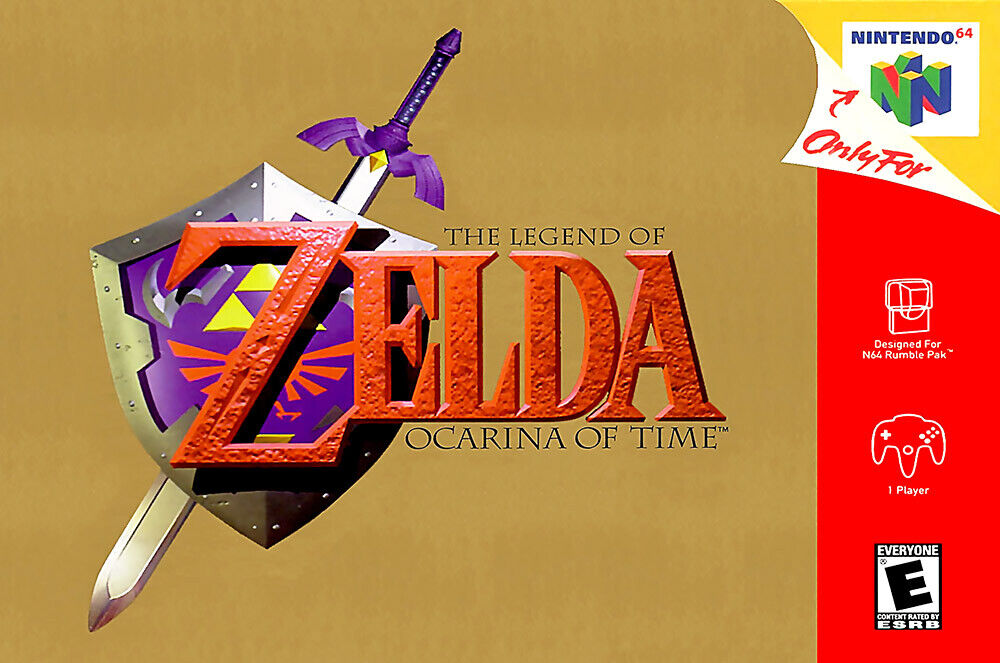Developer: Nintendo EAD Publisher: Nintendo
Released: November 21, 1998 Rated: E 10/10
Nothing is ever as hard to talk about in these profiles, or ever has been for me in retrospectives, streaming commentary, or social media commentary, than to talk about the games on the N64 where the reputation most precedes them. It’s hard to accurately describe why bad is bad, like in Superman 64, sure, but even harder to originally describe why good is so good, and why the greatest games are the greatest. But I feel like I can tell you why Ocarina of Time is so important, so timeless, so iconic, for a few reasons.

For starters, I would go so far as to say that as eternally heralded as one of the greatest as Ocarina of Time is, there’s almost a tendency for folks nowadays, 25 years on, to hesitate in their praise for it. Sometimes people don’t want to say it’s perfect (and it’s not, no game is), or at least nearly perfect. Sometimes people don’t want to say it’s their favorite Zelda title. There’s an appreciation towards more visually striking titles like Wind Waker and Twilight Princess; towards more open-ended titles like Breath of the Wild, to games more subversive to the Legend of Zelda formula, like Majora’s Mask. But what matters the most, I think, about recognizing the importance of Ocarina of Time, even if it’s not your favorite at this point, is this: your favorite adventure game, your least favorite adventure game, and every other open-world, grandiose, dungeon-based, exploration-heavy game you’ve played since the end of 1998, owes something to Ocarina of Time.

At the very minimum, Ocarina of Time’s legacy would be as the resounding success of the translation of Zelda’s core mechanics to 3D; the first view of Hyrule in the same revolutionary perspective that gamers saw when the system launched with Super Mario 64, exploring dungeons, traveling across Hyrule Field, battling monstrous bosses and classic Zelda enemies with an evolved appreciation for scale and intricacy in combat and puzzle solving. The months and months of previewed screenshots of a game referred to only as “Zelda 64” by Nintendo Power are proof positive of that – fans wanted to see Link, Ganon, Princess Zelda, Hyrule Castle, Death Mountain, Zora’s Domain, and more the way the new hardware could let them be portrayed, and the experience as a whole delivered on these pieces in the end, while also adding in plenty of further iconic pieces of Zelda lore such as the Gorons, the Deku Tree, Epona, the Gerudo and Ganondorf’s history, and perhaps most importantly, the focal point of the entire Zelda timeline (not that that was necessarily the plan at the time).

From a strictly mechanical standpoint, the Z-Targeting system, a day/night cycle, many important items like the hookshot and slingshot, the masks that we see later on in Majora’s Mask, and even the further realization of music as an integration of gameplay and puzzle solving were all key introductions made in Ocarina of Time. The subject of music, in particular, both as a gameplay mechanic and as texture and world-building tool, is especially lovely to explore. Learning the different songs on the two ocarinas in the game and playing them via the individual button presses to influence the world around you – something so key to the franchise that already revered music the way Zelda always has, is a wonderfully multifaceted step forward for the franchise.

Even just pulling back to look at the soundtrack and the way it represents the game and its status as this beautiful blueprint of the adventure genre for its new era is, once again, iconic, to say the least. It’s funny how many things about it can be seen as cliche in the modern era: covering the bases from the forest to the mountain to the lake/river; the desert, the light dungeon, the evil scary dungeon, make sure we cover percussive tribal beats and glassy synths to replicate water crystallizing into ice and whimsical, mischievous wind melodies to recapture the magic of childhood innocence lost. The level designs and list of OST compositions read like the brainstorming session of every developer’s first big open-ended project, because that’s what Ocarina of Time is: the jumping-off point for the action adventure genre to emulate, rethink, reshape, reimagine, twist, subvert, use as the foundation for, or completely dismantle for generations to come, so that we can still look back on it after years and years and maybe, just maybe, we can put the Master Sword back in the pedestal for just a moment.
Continuing Legacy
Well, like I said, just about everything can be claimed as part of its “legacy.” But to be more specific, Ocarina of Time received an excellent remake for the 3DS in 2011, and has been available on every Nintendo home console since its release, including a port alongside the Master Quest variation for the GameCube. It’s also a major focus of the N64 ROMhacking scene, with highlights including Voyager of Time, Nimpize Adventure, and The Missing Link.
Additional Information
Saves: Cartridge
Compatible With: Rumble Pak
Players: 1
Print Guides: Prima, BradyGames, Versus, Nintendo Power
Aggregate Critical Reception (GameRankings): 97.54%, based on 28 reviews
Other Releases: JP, November 21, 1998
EU, December 11, 1998
AU, December 18, 1998
My Streams
Commercials and Print Ads










2 responses to “The Legend of Zelda: Ocarina of Time”
[…] The Legend of Zelda: Ocarina of Time (N64) — The blueprint of adventure games for an entire generation and my first true Zelda experience. […]
[…] The Legend of Zelda: Ocarina of Time […]